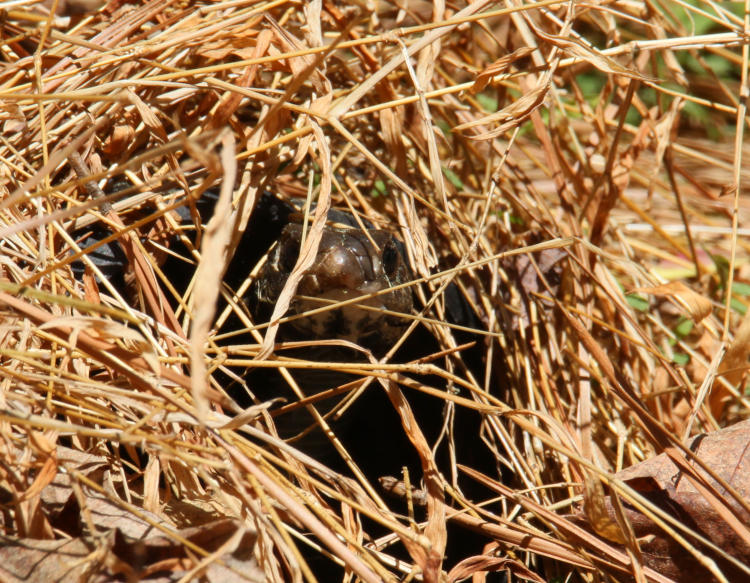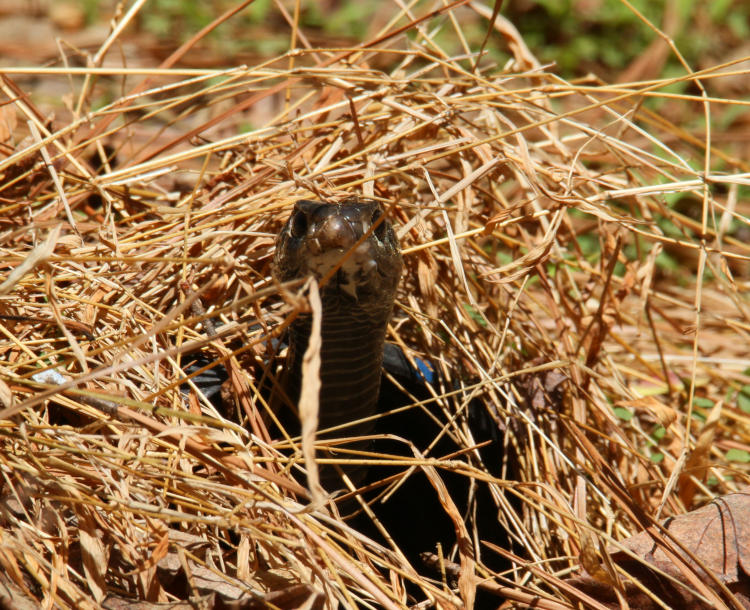Not much of one, but enough, anyway. You’ll see what I mean.
So in checking out the back twenty of Walkabout Estates today, I noticed that the sound of a leaf fluttering in the breeze was being remarkably persistent, and I looked down to find a sizable black snake stretched out across the dried grasses and leaves, vibrating its tail in a warning manner. It’s not just rattlesnakes that do this, though they have the handy noisemaker to enhance it, but this one had some dried leaves and so it wasn’t quite as ominous. Apparently it had been sunning itself and was trying to tell me to get lost, even as it slowly nosed into a patch of grasses. I was (stupidly, once again) without my camera, so I didn’t have the opportunity to get photos of it stretched out, but it was at least 1.5 meters in length and 4-5cm in width, and so I considered it an eastern rat snake.
I went in and grabbed the camera and came out cautiously, to find the snake peeking out from where it had secreted itself – I got two frames before it drew back in again.

That’s a standard garden hose that I was using to drain an overflow trough, and in midbody the snake was about twice the diameter. It withdrew right after this, so I went back in to get the long lens and tripod to do this right.
Unfortunately, the place where I had the clearest view and the best light (unlike the photo above) was also in the snake’s line of vision, and it could see me set up and squat cross-legged on the ground, so it wasn’t venturing forth as quickly as it just had. This became a test of patience, both of us trying to out-wait the other. Eventually, I could just see the nose of the snake within the shadows.

I didn’t realize it at the time, but these photos made it apparent when I examined them closely: the snake had holed up in a drainage pipe, an extension of the downspouts from the house, completely obscured by the winter detritus – that explained how it had concealed its significant bulk so completely.

After another minute or so, it advanced very slightly, just enough to show that it was advancing. We’re not talking fast, here.
Another few minutes, and the head was raising slightly.

Part of the problem was, every once in a while, it would waggle its head from side to side slightly, which I wanted to get on video, but this meant changing my hand positions and likely alerting the snake that I was still indeed animate, whereupon it would hold still again for a while.

By now, i was getting enough of a look under its neck to realize that this was not an eastern rat snake, but instead a northern black racer (Coluber constrictor constrictor.) Which was a little surprising to me, since I’ve never seen one anywhere near this size, impressive even for a rat snake. But it helped explain the time that was elapsing, since this species is cautious by nature.

Naturally, with clear photos I could go back and compare the chin markings against those of the black racer that I’ve (twice) found in the vicinity. Aside from being noticeably larger (not outside the realm of possibility,) this one was marked differently, so I’m pretty certain it’s not the same.
And not once did it ever twitch away from facing directly towards me. I was a good five meters off, to avoid making it hesitant, but this was obviously not enough. It has been fifteen minutes since the first peek out of the drainpipe, and no motion that it made was enough to attract anything’s attention.

Now another eleven minutes had passed, with the snake extended better than 20cm off the ground, and we’d reached an impasse: my sitting position wasn’t the best, and my right leg was in some serious pain, to say nothing of the 3D printer running on my desk that really shouldn’t have been unattended that long. Conceding the victory to the snake, I started packing up the equipment, but it wasn’t until I stood up that the snake finally withdrew into the pipe again. As I was shifting position, I thought something had hung up on my foot and was dragging around, until I realized that it was my foot, fast asleep and feeling nothing from my cross-legged perch. So, little lesson: make sure that you’re really comfortable when you do stuff like this. But hey, I made a decent attempt anyway.
The weather was quite warm today, so much so that I opened the greenhouse to vent a bit, and noticed some of the lizards scampering around – below is a juvenile American five-lined skink (Plestiodon fasciatus) that played hide-and-seek with me around the deck, but proved a lot easier to get a sharp photo of than the racer.

That brilliant blue tail is a defensive mechanism, but not an indication of toxicity like the bright colors of many other species. Instead, it detaches easily when the species is attacked, and will writhe energetically for up to several minutes when it does so, hopefully attracting the attention of the predator while the skink slinks away. A new tail grows back within a few months, and it’s unclear whether the skink even feels the detachment. Only the juveniles have this bright coloration, though – presumably the adults have learned how to avoid attackers. I also don’t know if the adult tails detach quite so effortlessly, though I’ve definitely seen adults regrowing their tails.
Anyway, that was this afternoon’s encounter, and little lesson. I’m looking into a nice massaging lounge chair for my shooting blinds.



















































